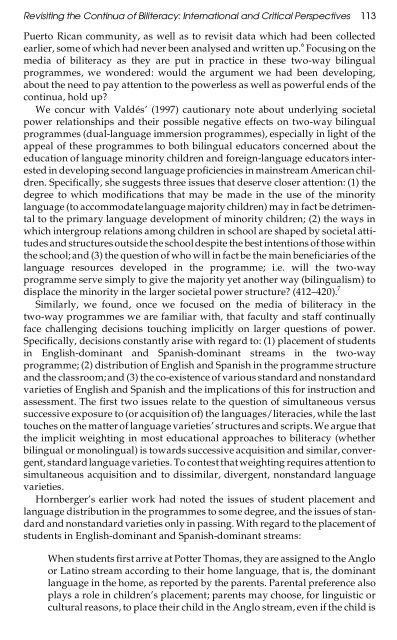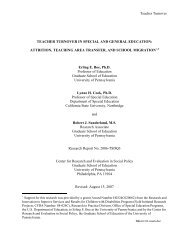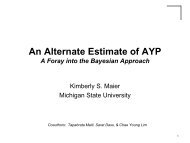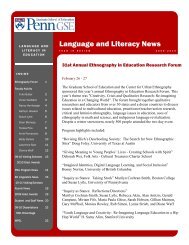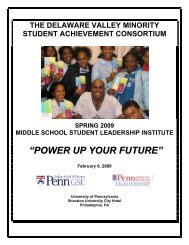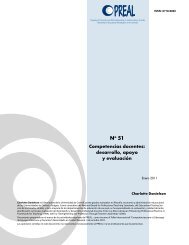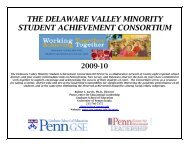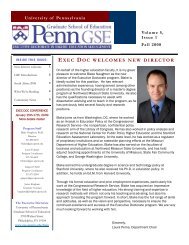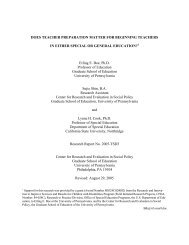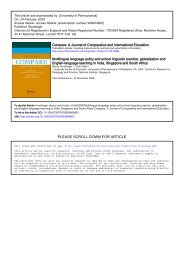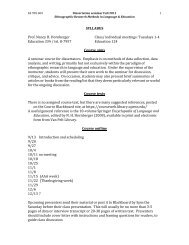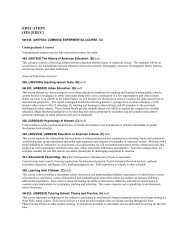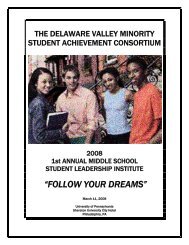Revisiting the Continua of Biliteracy - Penn GSE - University of ...
Revisiting the Continua of Biliteracy - Penn GSE - University of ...
Revisiting the Continua of Biliteracy - Penn GSE - University of ...
Create successful ePaper yourself
Turn your PDF publications into a flip-book with our unique Google optimized e-Paper software.
<strong>Revisiting</strong> <strong>the</strong> <strong>Continua</strong> <strong>of</strong> <strong>Biliteracy</strong>: International and Critical Perspectives 113<br />
Puerto Rican community, as well as to revisit data which had been collected<br />
earlier, some <strong>of</strong> which had never been analysed and written up. 6 Focusing on <strong>the</strong><br />
media <strong>of</strong> biliteracy as <strong>the</strong>y are put in practice in <strong>the</strong>se two-way bilingual<br />
programmes, we wondered: would <strong>the</strong> argument we had been developing,<br />
about <strong>the</strong> need to pay attention to <strong>the</strong> powerless as well as powerful ends <strong>of</strong> <strong>the</strong><br />
continua, hold up?<br />
We concur with Valdés’ (1997) cautionary note about underlying societal<br />
power relationships and <strong>the</strong>ir possible negative effects on two-way bilingual<br />
programmes (dual-language immersion programmes), especially in light <strong>of</strong> <strong>the</strong><br />
appeal <strong>of</strong> <strong>the</strong>se programmes to both bilingual educators concerned about <strong>the</strong><br />
education <strong>of</strong> language minority children and foreign-language educators interested<br />
in developing second language pr<strong>of</strong>iciencies in mainstream American children.<br />
Specifically, she suggests three issues that deserve closer attention: (1) <strong>the</strong><br />
degree to which modifications that may be made in <strong>the</strong> use <strong>of</strong> <strong>the</strong> minority<br />
language (to accommodatelanguage majority children) may in fact be detrimental<br />
to <strong>the</strong> primary language development <strong>of</strong> minority children; (2) <strong>the</strong> ways in<br />
which intergroup relations among children in school are shaped by societal attitudes<br />
and structures outside <strong>the</strong> schooldespite <strong>the</strong> best intentions <strong>of</strong> those within<br />
<strong>the</strong> school; and (3) <strong>the</strong> question <strong>of</strong> who will in fact be <strong>the</strong> main beneficiaries <strong>of</strong> <strong>the</strong><br />
language resources developed in <strong>the</strong> programme; i.e. will <strong>the</strong> two-way<br />
programme serve simply to give <strong>the</strong> majority yet ano<strong>the</strong>r way (bilingualism) to<br />
displace <strong>the</strong> minority in <strong>the</strong> larger societal power structure? (412–420). 7<br />
Similarly, we found, once we focused on <strong>the</strong> media <strong>of</strong> biliteracy in <strong>the</strong><br />
two-way programmes we are familiar with, that faculty and staff continually<br />
face challenging decisions touching implicitly on larger questions <strong>of</strong> power.<br />
Specifically, decisions constantly arise with regard to: (1) placement <strong>of</strong> students<br />
in English-dominant and Spanish-dominant streams in <strong>the</strong> two-way<br />
programme; (2) distribution <strong>of</strong> English and Spanish in <strong>the</strong> programme structure<br />
and <strong>the</strong> classroom; and (3) <strong>the</strong> co-existence <strong>of</strong> various standard and nonstandard<br />
varieties <strong>of</strong> English and Spanish and <strong>the</strong> implications <strong>of</strong> this for instruction and<br />
assessment. The first two issues relate to <strong>the</strong> question <strong>of</strong> simultaneous versus<br />
successive exposure to (or acquisition <strong>of</strong>) <strong>the</strong> languages/literacies, while <strong>the</strong> last<br />
touches on <strong>the</strong> matter <strong>of</strong> language varieties’ structures and scripts. We argue that<br />
<strong>the</strong> implicit weighting in most educational approaches to biliteracy (whe<strong>the</strong>r<br />
bilingual or monolingual) is towards successive acquisition and similar, convergent,<br />
standard language varieties. To contest that weighting requires attention to<br />
simultaneous acquisition and to dissimilar, divergent, nonstandard language<br />
varieties.<br />
Hornberger’s earlier work had noted <strong>the</strong> issues <strong>of</strong> student placement and<br />
language distribution in <strong>the</strong> programmes to some degree, and <strong>the</strong> issues <strong>of</strong> standard<br />
and nonstandard varieties only in passing. With regard to <strong>the</strong> placement <strong>of</strong><br />
students in English-dominant and Spanish-dominant streams:<br />
When students first arrive at Potter Thomas, <strong>the</strong>y are assigned to <strong>the</strong> Anglo<br />
or Latino stream according to <strong>the</strong>ir home language, that is, <strong>the</strong> dominant<br />
language in <strong>the</strong> home, as reported by <strong>the</strong> parents. Parental preference also<br />
plays a role in children’s placement; parents may choose, for linguistic or<br />
cultural reasons, to place <strong>the</strong>ir child in <strong>the</strong> Anglo stream, even if <strong>the</strong> child is


